Systems Analysis and Design: A Comprehensive Systems Investigation
VerifiedAdded on 2024/04/26
|29
|5985
|419
Report
AI Summary
This report provides a comprehensive overview of Systems Analysis and Design principles, focusing on the System Development Life Cycle (SDLC), feasibility studies, and system investigations. It begins by evaluating various SDLC models, including Rapid Applications Design (RAD), Spiral, Iterative, Agile, Waterfall, V-Shape, and Prototyping, highlighting their advantages and disadvantages. The report then discusses the importance of feasibility studies, detailing the components of a feasibility report and assessing the impact of different feasibility criteria on a systems investigation. Furthermore, it outlines the steps involved in undertaking a systems investigation to meet a business need, utilizing appropriate systems analysis tools and techniques such as Entity Relationship Diagrams, Context Diagrams, and Data Flow Diagrams (DFDs). The document also emphasizes the creation of supporting documentation and evaluates how user and system requirements are addressed throughout the systems investigation process. The report references a case study of Adroit Ads, a London-based advertising agency, to contextualize the application of these principles.

Systems Analysis and Design
0
0
Paraphrase This Document
Need a fresh take? Get an instant paraphrase of this document with our AI Paraphraser
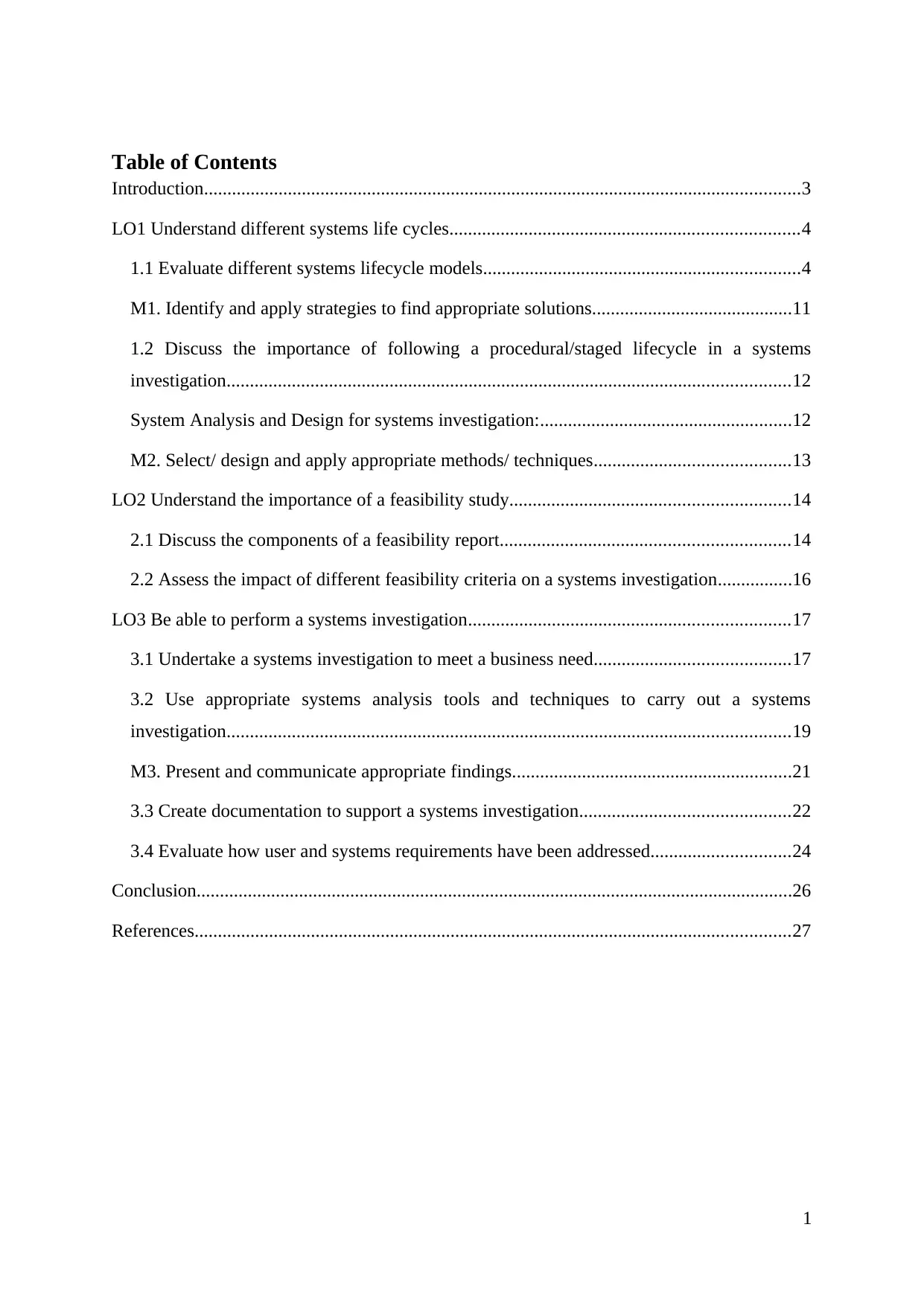
Table of Contents
Introduction................................................................................................................................3
LO1 Understand different systems life cycles...........................................................................4
1.1 Evaluate different systems lifecycle models....................................................................4
M1. Identify and apply strategies to find appropriate solutions...........................................11
1.2 Discuss the importance of following a procedural/staged lifecycle in a systems
investigation.........................................................................................................................12
System Analysis and Design for systems investigation:......................................................12
M2. Select/ design and apply appropriate methods/ techniques..........................................13
LO2 Understand the importance of a feasibility study............................................................14
2.1 Discuss the components of a feasibility report..............................................................14
2.2 Assess the impact of different feasibility criteria on a systems investigation................16
LO3 Be able to perform a systems investigation.....................................................................17
3.1 Undertake a systems investigation to meet a business need..........................................17
3.2 Use appropriate systems analysis tools and techniques to carry out a systems
investigation.........................................................................................................................19
M3. Present and communicate appropriate findings............................................................21
3.3 Create documentation to support a systems investigation.............................................22
3.4 Evaluate how user and systems requirements have been addressed..............................24
Conclusion................................................................................................................................26
References................................................................................................................................27
1
Introduction................................................................................................................................3
LO1 Understand different systems life cycles...........................................................................4
1.1 Evaluate different systems lifecycle models....................................................................4
M1. Identify and apply strategies to find appropriate solutions...........................................11
1.2 Discuss the importance of following a procedural/staged lifecycle in a systems
investigation.........................................................................................................................12
System Analysis and Design for systems investigation:......................................................12
M2. Select/ design and apply appropriate methods/ techniques..........................................13
LO2 Understand the importance of a feasibility study............................................................14
2.1 Discuss the components of a feasibility report..............................................................14
2.2 Assess the impact of different feasibility criteria on a systems investigation................16
LO3 Be able to perform a systems investigation.....................................................................17
3.1 Undertake a systems investigation to meet a business need..........................................17
3.2 Use appropriate systems analysis tools and techniques to carry out a systems
investigation.........................................................................................................................19
M3. Present and communicate appropriate findings............................................................21
3.3 Create documentation to support a systems investigation.............................................22
3.4 Evaluate how user and systems requirements have been addressed..............................24
Conclusion................................................................................................................................26
References................................................................................................................................27
1
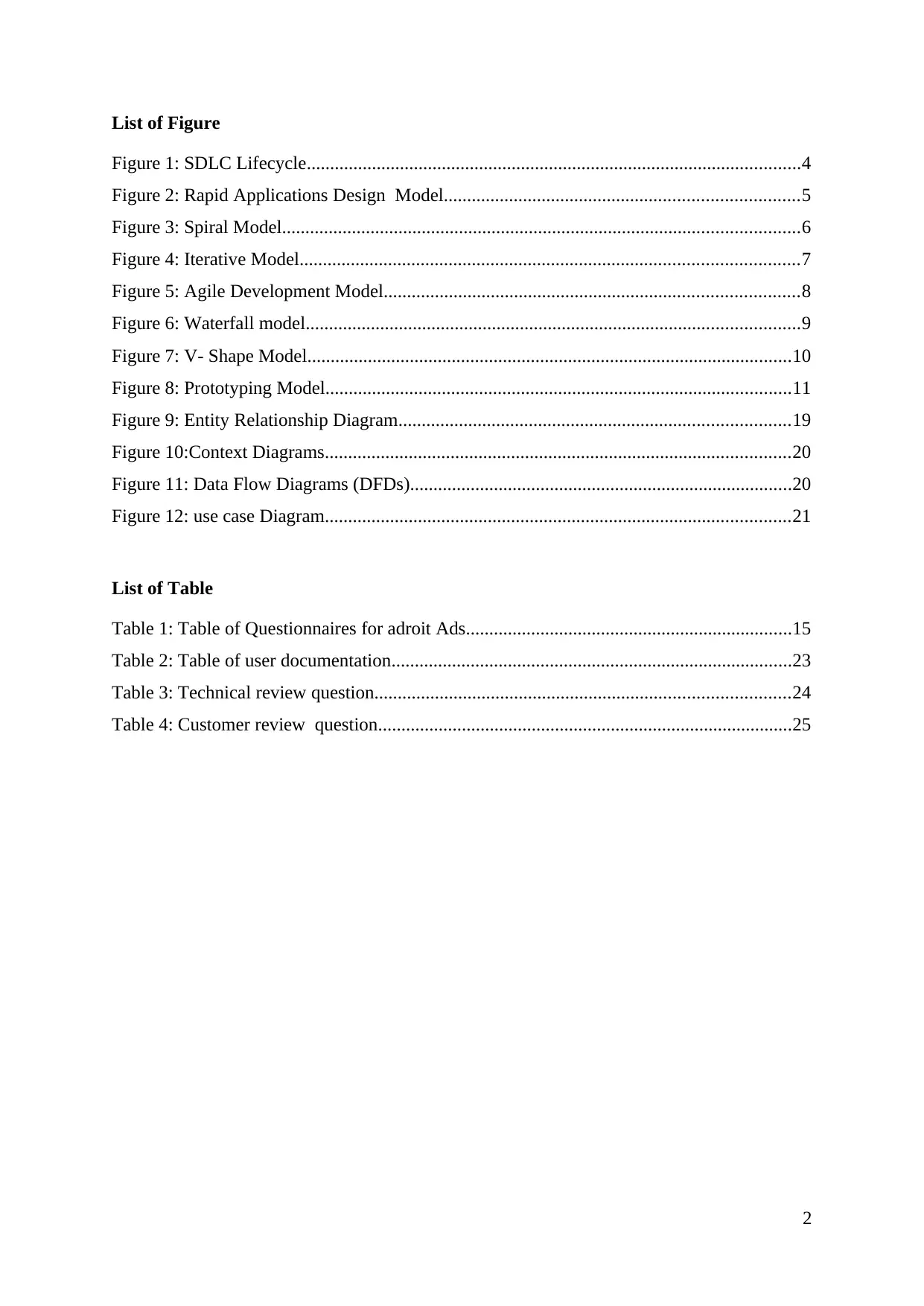
List of Figure
Figure 1: SDLC Lifecycle..........................................................................................................4
Figure 2: Rapid Applications Design Model............................................................................5
Figure 3: Spiral Model...............................................................................................................6
Figure 4: Iterative Model...........................................................................................................7
Figure 5: Agile Development Model.........................................................................................8
Figure 6: Waterfall model..........................................................................................................9
Figure 7: V- Shape Model........................................................................................................10
Figure 8: Prototyping Model....................................................................................................11
Figure 9: Entity Relationship Diagram....................................................................................19
Figure 10:Context Diagrams....................................................................................................20
Figure 11: Data Flow Diagrams (DFDs)..................................................................................20
Figure 12: use case Diagram....................................................................................................21
List of Table
Table 1: Table of Questionnaires for adroit Ads......................................................................15
Table 2: Table of user documentation......................................................................................23
Table 3: Technical review question.........................................................................................24
Table 4: Customer review question.........................................................................................25
2
Figure 1: SDLC Lifecycle..........................................................................................................4
Figure 2: Rapid Applications Design Model............................................................................5
Figure 3: Spiral Model...............................................................................................................6
Figure 4: Iterative Model...........................................................................................................7
Figure 5: Agile Development Model.........................................................................................8
Figure 6: Waterfall model..........................................................................................................9
Figure 7: V- Shape Model........................................................................................................10
Figure 8: Prototyping Model....................................................................................................11
Figure 9: Entity Relationship Diagram....................................................................................19
Figure 10:Context Diagrams....................................................................................................20
Figure 11: Data Flow Diagrams (DFDs)..................................................................................20
Figure 12: use case Diagram....................................................................................................21
List of Table
Table 1: Table of Questionnaires for adroit Ads......................................................................15
Table 2: Table of user documentation......................................................................................23
Table 3: Technical review question.........................................................................................24
Table 4: Customer review question.........................................................................................25
2
⊘ This is a preview!⊘
Do you want full access?
Subscribe today to unlock all pages.

Trusted by 1+ million students worldwide
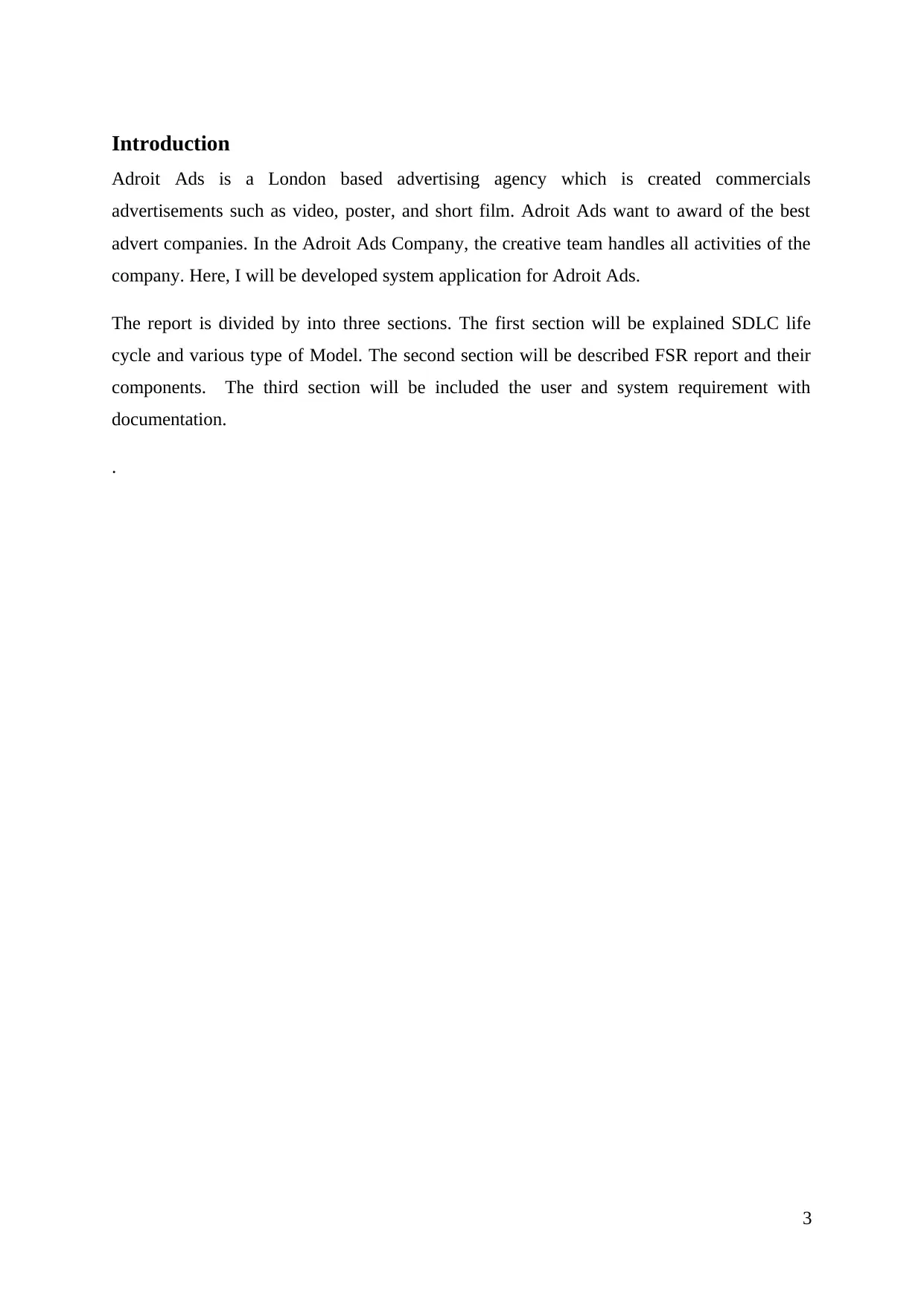
Introduction
Adroit Ads is a London based advertising agency which is created commercials
advertisements such as video, poster, and short film. Adroit Ads want to award of the best
advert companies. In the Adroit Ads Company, the creative team handles all activities of the
company. Here, I will be developed system application for Adroit Ads.
The report is divided by into three sections. The first section will be explained SDLC life
cycle and various type of Model. The second section will be described FSR report and their
components. The third section will be included the user and system requirement with
documentation.
.
3
Adroit Ads is a London based advertising agency which is created commercials
advertisements such as video, poster, and short film. Adroit Ads want to award of the best
advert companies. In the Adroit Ads Company, the creative team handles all activities of the
company. Here, I will be developed system application for Adroit Ads.
The report is divided by into three sections. The first section will be explained SDLC life
cycle and various type of Model. The second section will be described FSR report and their
components. The third section will be included the user and system requirement with
documentation.
.
3
Paraphrase This Document
Need a fresh take? Get an instant paraphrase of this document with our AI Paraphraser
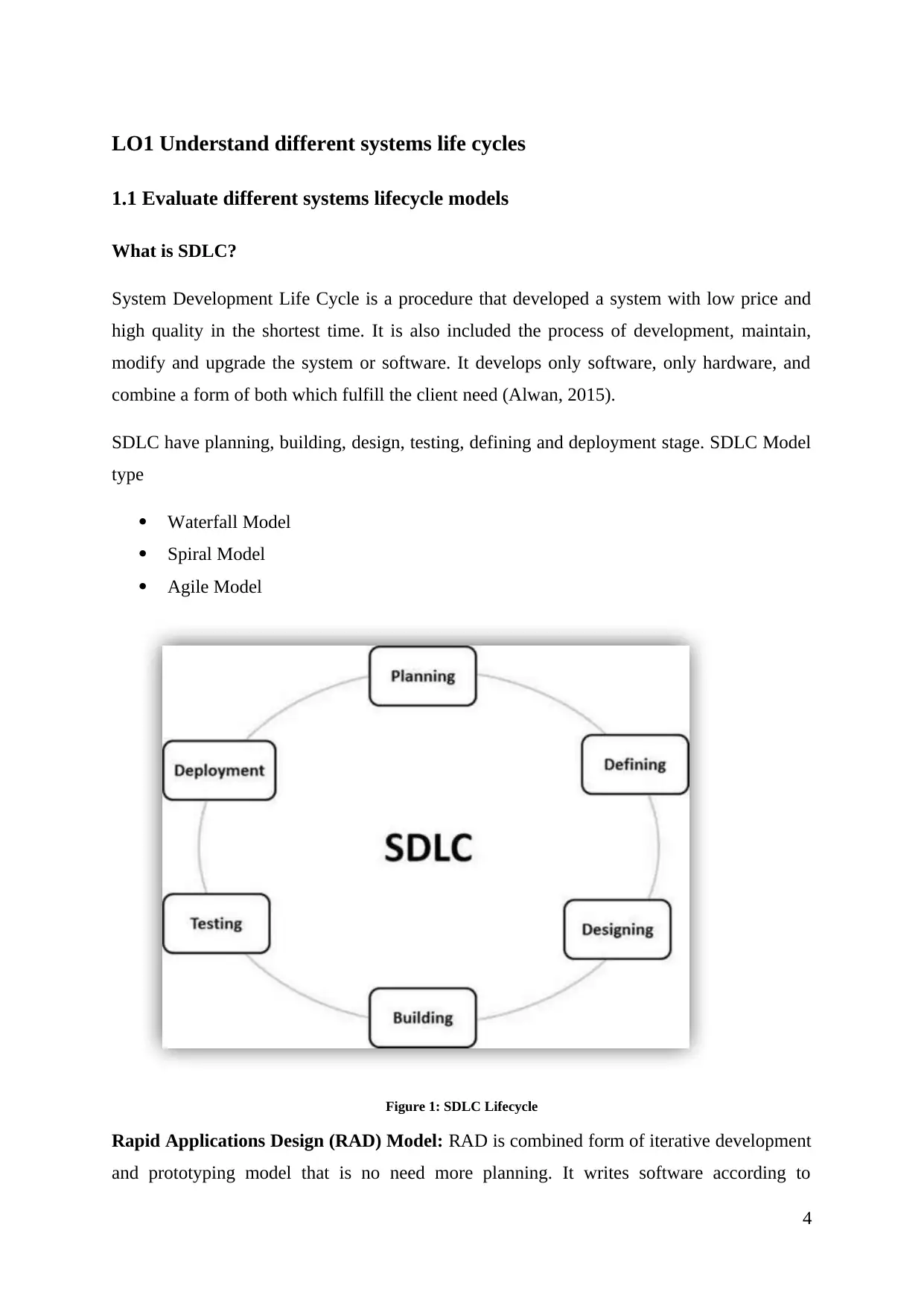
LO1 Understand different systems life cycles
1.1 Evaluate different systems lifecycle models
What is SDLC?
System Development Life Cycle is a procedure that developed a system with low price and
high quality in the shortest time. It is also included the process of development, maintain,
modify and upgrade the system or software. It develops only software, only hardware, and
combine a form of both which fulfill the client need (Alwan, 2015).
SDLC have planning, building, design, testing, defining and deployment stage. SDLC Model
type
Waterfall Model
Spiral Model
Agile Model
Figure 1: SDLC Lifecycle
Rapid Applications Design (RAD) Model: RAD is combined form of iterative development
and prototyping model that is no need more planning. It writes software according to
4
1.1 Evaluate different systems lifecycle models
What is SDLC?
System Development Life Cycle is a procedure that developed a system with low price and
high quality in the shortest time. It is also included the process of development, maintain,
modify and upgrade the system or software. It develops only software, only hardware, and
combine a form of both which fulfill the client need (Alwan, 2015).
SDLC have planning, building, design, testing, defining and deployment stage. SDLC Model
type
Waterfall Model
Spiral Model
Agile Model
Figure 1: SDLC Lifecycle
Rapid Applications Design (RAD) Model: RAD is combined form of iterative development
and prototyping model that is no need more planning. It writes software according to
4
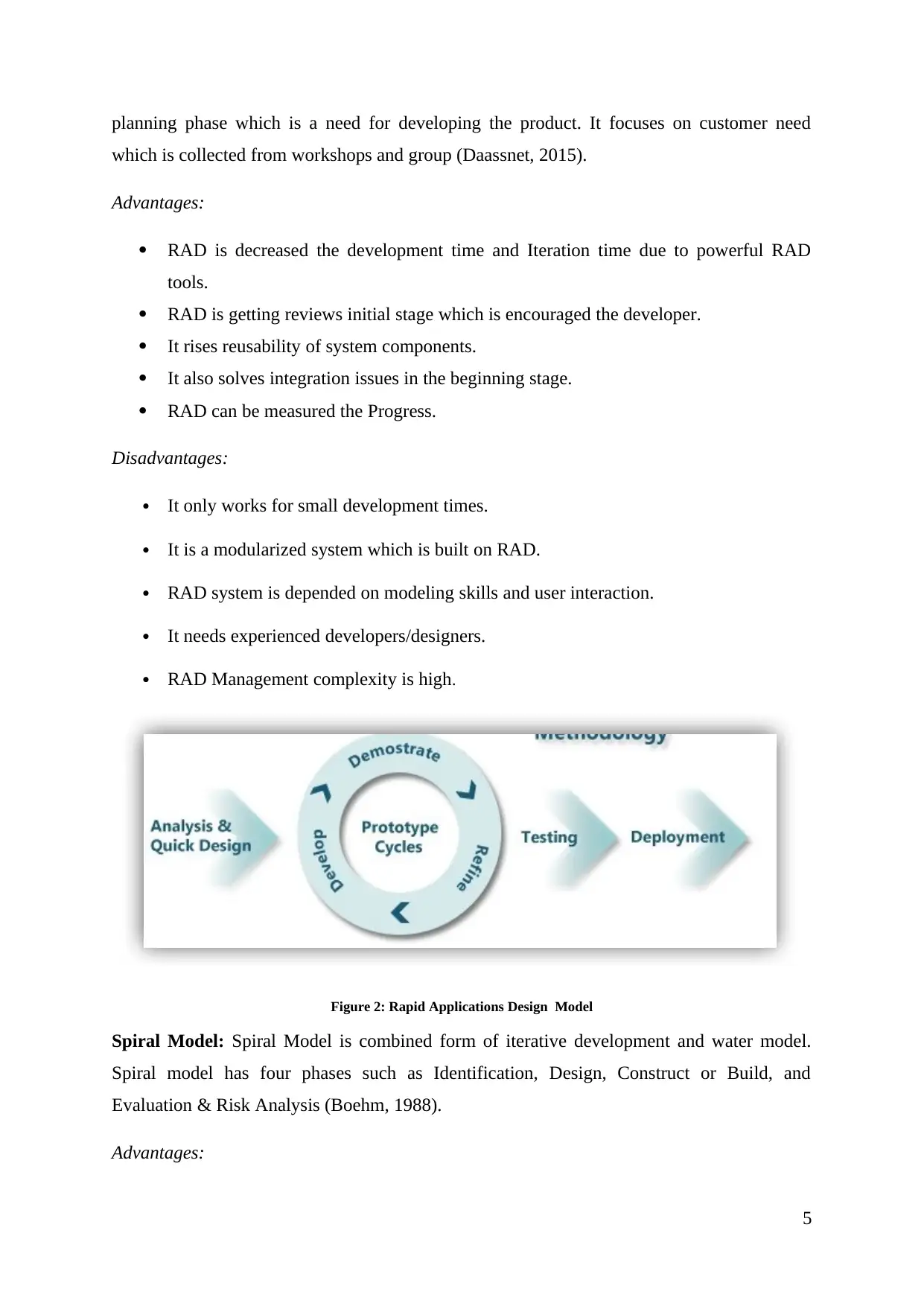
planning phase which is a need for developing the product. It focuses on customer need
which is collected from workshops and group (Daassnet, 2015).
Advantages:
RAD is decreased the development time and Iteration time due to powerful RAD
tools.
RAD is getting reviews initial stage which is encouraged the developer.
It rises reusability of system components.
It also solves integration issues in the beginning stage.
RAD can be measured the Progress.
Disadvantages:
It only works for small development times.
It is a modularized system which is built on RAD.
RAD system is depended on modeling skills and user interaction.
It needs experienced developers/designers.
RAD Management complexity is high.
Figure 2: Rapid Applications Design Model
Spiral Model: Spiral Model is combined form of iterative development and water model.
Spiral model has four phases such as Identification, Design, Construct or Build, and
Evaluation & Risk Analysis (Boehm, 1988).
Advantages:
5
which is collected from workshops and group (Daassnet, 2015).
Advantages:
RAD is decreased the development time and Iteration time due to powerful RAD
tools.
RAD is getting reviews initial stage which is encouraged the developer.
It rises reusability of system components.
It also solves integration issues in the beginning stage.
RAD can be measured the Progress.
Disadvantages:
It only works for small development times.
It is a modularized system which is built on RAD.
RAD system is depended on modeling skills and user interaction.
It needs experienced developers/designers.
RAD Management complexity is high.
Figure 2: Rapid Applications Design Model
Spiral Model: Spiral Model is combined form of iterative development and water model.
Spiral model has four phases such as Identification, Design, Construct or Build, and
Evaluation & Risk Analysis (Boehm, 1988).
Advantages:
5
⊘ This is a preview!⊘
Do you want full access?
Subscribe today to unlock all pages.

Trusted by 1+ million students worldwide

The need of client is more accurately defined and Changing need is acceptable during
any phase.
It is supported extensive prototypes.
The user can be connected with the system until early phase.
It is broke the system small part and risk is managed by risk management.
Disadvantages:
In the spiral model, system Management is a complex process.
System product is not defined early phase.
It is an indefinite process.
It is an expensive process for the small project.
Figure 3: Spiral Model
Iterative Model: Iterative Model is broke the project small parts and then developed in each
iterative process. After all part developed, the complete system is implemented and
developed. It is not attempted full specification of need in the starting phase. In the starting
phase of development, the model is implementing and specifying of software. It is a
repeating process where each repeating process created a new product at the end of the
iteration (Powell-Morse, 2016).
Advantages:
6
any phase.
It is supported extensive prototypes.
The user can be connected with the system until early phase.
It is broke the system small part and risk is managed by risk management.
Disadvantages:
In the spiral model, system Management is a complex process.
System product is not defined early phase.
It is an indefinite process.
It is an expensive process for the small project.
Figure 3: Spiral Model
Iterative Model: Iterative Model is broke the project small parts and then developed in each
iterative process. After all part developed, the complete system is implemented and
developed. It is not attempted full specification of need in the starting phase. In the starting
phase of development, the model is implementing and specifying of software. It is a
repeating process where each repeating process created a new product at the end of the
iteration (Powell-Morse, 2016).
Advantages:
6
Paraphrase This Document
Need a fresh take? Get an instant paraphrase of this document with our AI Paraphraser
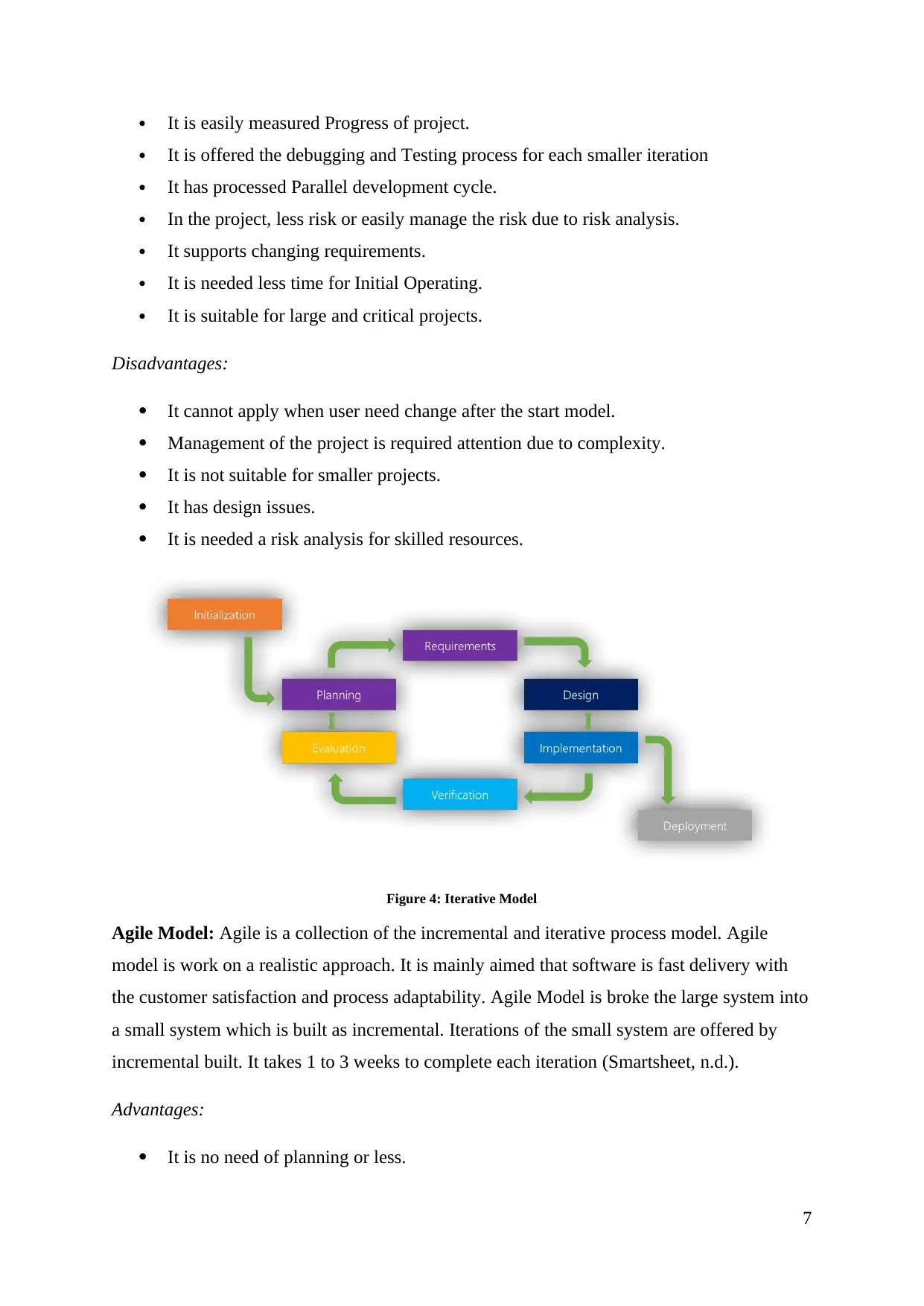
It is easily measured Progress of project.
It is offered the debugging and Testing process for each smaller iteration
It has processed Parallel development cycle.
In the project, less risk or easily manage the risk due to risk analysis.
It supports changing requirements.
It is needed less time for Initial Operating.
It is suitable for large and critical projects.
Disadvantages:
It cannot apply when user need change after the start model.
Management of the project is required attention due to complexity.
It is not suitable for smaller projects.
It has design issues.
It is needed a risk analysis for skilled resources.
Figure 4: Iterative Model
Agile Model: Agile is a collection of the incremental and iterative process model. Agile
model is work on a realistic approach. It is mainly aimed that software is fast delivery with
the customer satisfaction and process adaptability. Agile Model is broke the large system into
a small system which is built as incremental. Iterations of the small system are offered by
incremental built. It takes 1 to 3 weeks to complete each iteration (Smartsheet, n.d.).
Advantages:
It is no need of planning or less.
7
It is offered the debugging and Testing process for each smaller iteration
It has processed Parallel development cycle.
In the project, less risk or easily manage the risk due to risk analysis.
It supports changing requirements.
It is needed less time for Initial Operating.
It is suitable for large and critical projects.
Disadvantages:
It cannot apply when user need change after the start model.
Management of the project is required attention due to complexity.
It is not suitable for smaller projects.
It has design issues.
It is needed a risk analysis for skilled resources.
Figure 4: Iterative Model
Agile Model: Agile is a collection of the incremental and iterative process model. Agile
model is work on a realistic approach. It is mainly aimed that software is fast delivery with
the customer satisfaction and process adaptability. Agile Model is broke the large system into
a small system which is built as incremental. Iterations of the small system are offered by
incremental built. It takes 1 to 3 weeks to complete each iteration (Smartsheet, n.d.).
Advantages:
It is no need of planning or less.
7

Agile process is appropriate for fixed or changing need.
Agile process is needed min Resource and rule for system development.
It is easy to manage because agile process offered flexibility to developers.
Disadvantages:
It does not handle complex dependencies during system development.
In the Agile process, Customer interaction is more which may be the wrong direction
to the team.
It holds risk in the form maintainability, extensibility, and sustainability. Not suitable
for handling complex dependencies.
Figure 5: Agile Development Model
Waterfall Model: It is also called the linear-sequential life cycle model. It is used where
requirements and Product are well defined. Technology and Ample resources for waterfall
model are freely available. In the waterfall model, customer interaction is less because
customer interacts with the software after completed (Calikus, 2015).
Advantages:
Waterfall model is working small project because its needs are well defined.
It is work single stage at a time so waterfall phase is not overlapped
8
Agile process is needed min Resource and rule for system development.
It is easy to manage because agile process offered flexibility to developers.
Disadvantages:
It does not handle complex dependencies during system development.
In the Agile process, Customer interaction is more which may be the wrong direction
to the team.
It holds risk in the form maintainability, extensibility, and sustainability. Not suitable
for handling complex dependencies.
Figure 5: Agile Development Model
Waterfall Model: It is also called the linear-sequential life cycle model. It is used where
requirements and Product are well defined. Technology and Ample resources for waterfall
model are freely available. In the waterfall model, customer interaction is less because
customer interacts with the software after completed (Calikus, 2015).
Advantages:
Waterfall model is working small project because its needs are well defined.
It is work single stage at a time so waterfall phase is not overlapped
8
⊘ This is a preview!⊘
Do you want full access?
Subscribe today to unlock all pages.

Trusted by 1+ million students worldwide
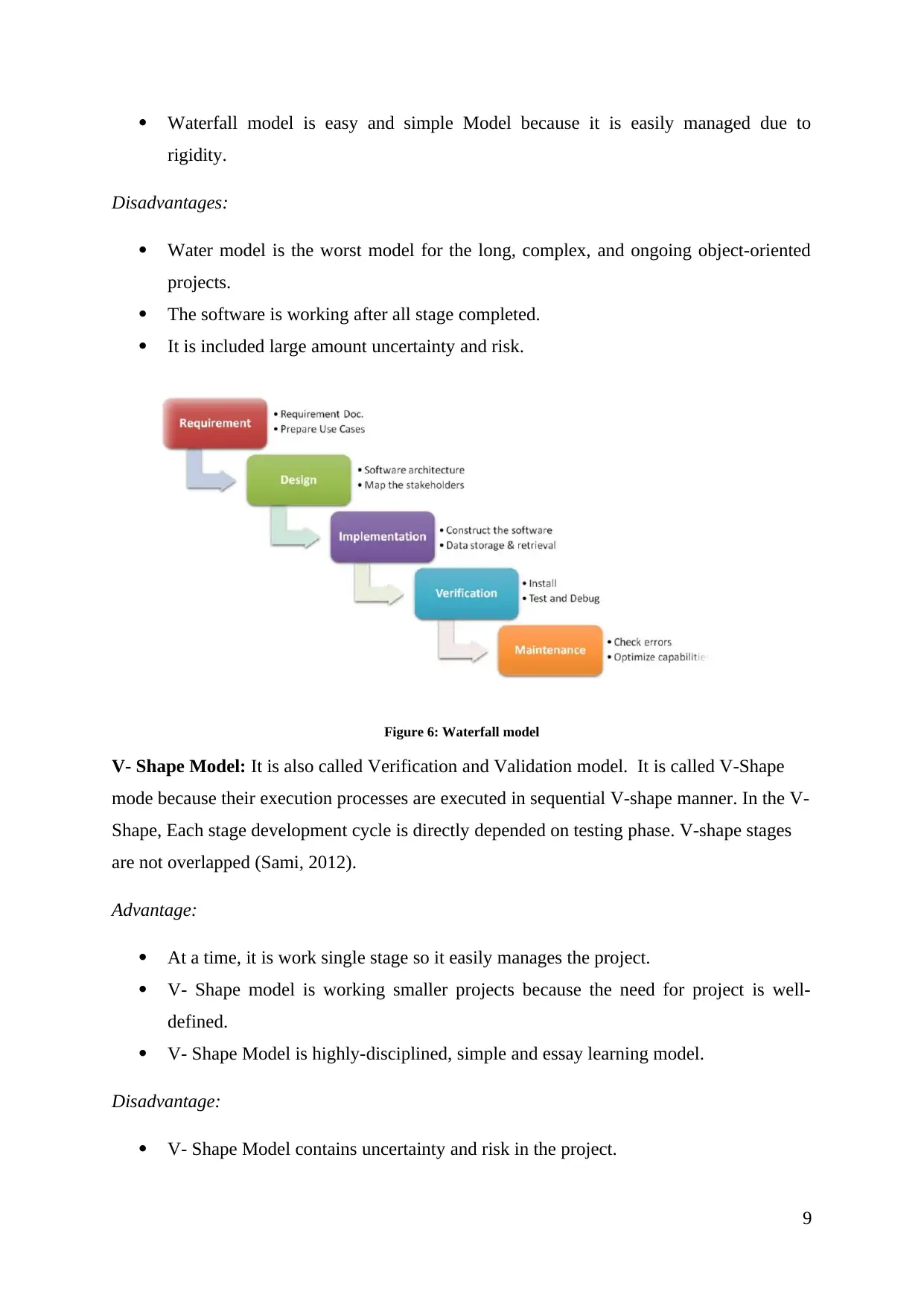
Waterfall model is easy and simple Model because it is easily managed due to
rigidity.
Disadvantages:
Water model is the worst model for the long, complex, and ongoing object-oriented
projects.
The software is working after all stage completed.
It is included large amount uncertainty and risk.
Figure 6: Waterfall model
V- Shape Model: It is also called Verification and Validation model. It is called V-Shape
mode because their execution processes are executed in sequential V-shape manner. In the V-
Shape, Each stage development cycle is directly depended on testing phase. V-shape stages
are not overlapped (Sami, 2012).
Advantage:
At a time, it is work single stage so it easily manages the project.
V- Shape model is working smaller projects because the need for project is well-
defined.
V- Shape Model is highly-disciplined, simple and essay learning model.
Disadvantage:
V- Shape Model contains uncertainty and risk in the project.
9
rigidity.
Disadvantages:
Water model is the worst model for the long, complex, and ongoing object-oriented
projects.
The software is working after all stage completed.
It is included large amount uncertainty and risk.
Figure 6: Waterfall model
V- Shape Model: It is also called Verification and Validation model. It is called V-Shape
mode because their execution processes are executed in sequential V-shape manner. In the V-
Shape, Each stage development cycle is directly depended on testing phase. V-shape stages
are not overlapped (Sami, 2012).
Advantage:
At a time, it is work single stage so it easily manages the project.
V- Shape model is working smaller projects because the need for project is well-
defined.
V- Shape Model is highly-disciplined, simple and essay learning model.
Disadvantage:
V- Shape Model contains uncertainty and risk in the project.
9
Paraphrase This Document
Need a fresh take? Get an instant paraphrase of this document with our AI Paraphraser
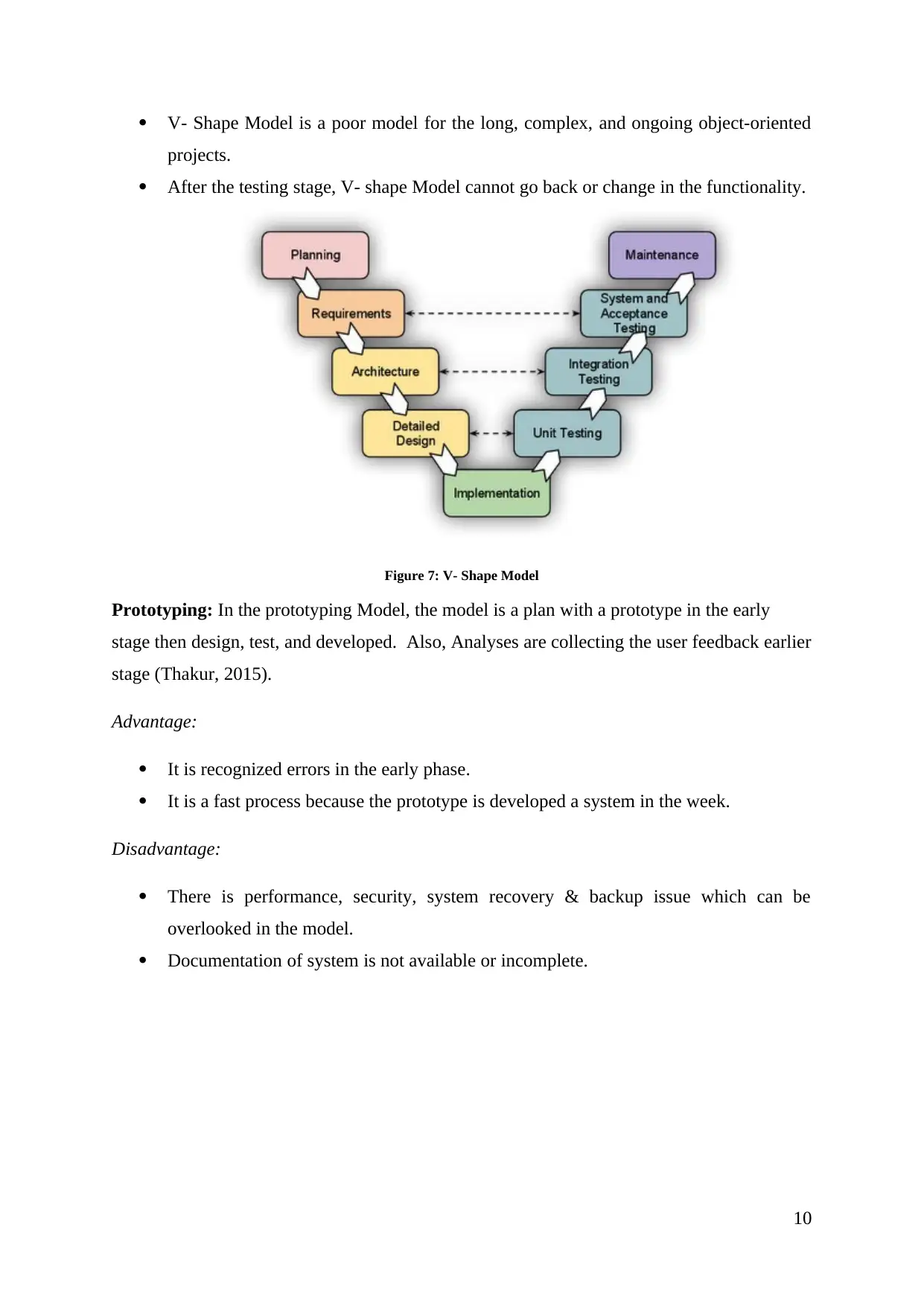
V- Shape Model is a poor model for the long, complex, and ongoing object-oriented
projects.
After the testing stage, V- shape Model cannot go back or change in the functionality.
Figure 7: V- Shape Model
Prototyping: In the prototyping Model, the model is a plan with a prototype in the early
stage then design, test, and developed. Also, Analyses are collecting the user feedback earlier
stage (Thakur, 2015).
Advantage:
It is recognized errors in the early phase.
It is a fast process because the prototype is developed a system in the week.
Disadvantage:
There is performance, security, system recovery & backup issue which can be
overlooked in the model.
Documentation of system is not available or incomplete.
10
projects.
After the testing stage, V- shape Model cannot go back or change in the functionality.
Figure 7: V- Shape Model
Prototyping: In the prototyping Model, the model is a plan with a prototype in the early
stage then design, test, and developed. Also, Analyses are collecting the user feedback earlier
stage (Thakur, 2015).
Advantage:
It is recognized errors in the early phase.
It is a fast process because the prototype is developed a system in the week.
Disadvantage:
There is performance, security, system recovery & backup issue which can be
overlooked in the model.
Documentation of system is not available or incomplete.
10
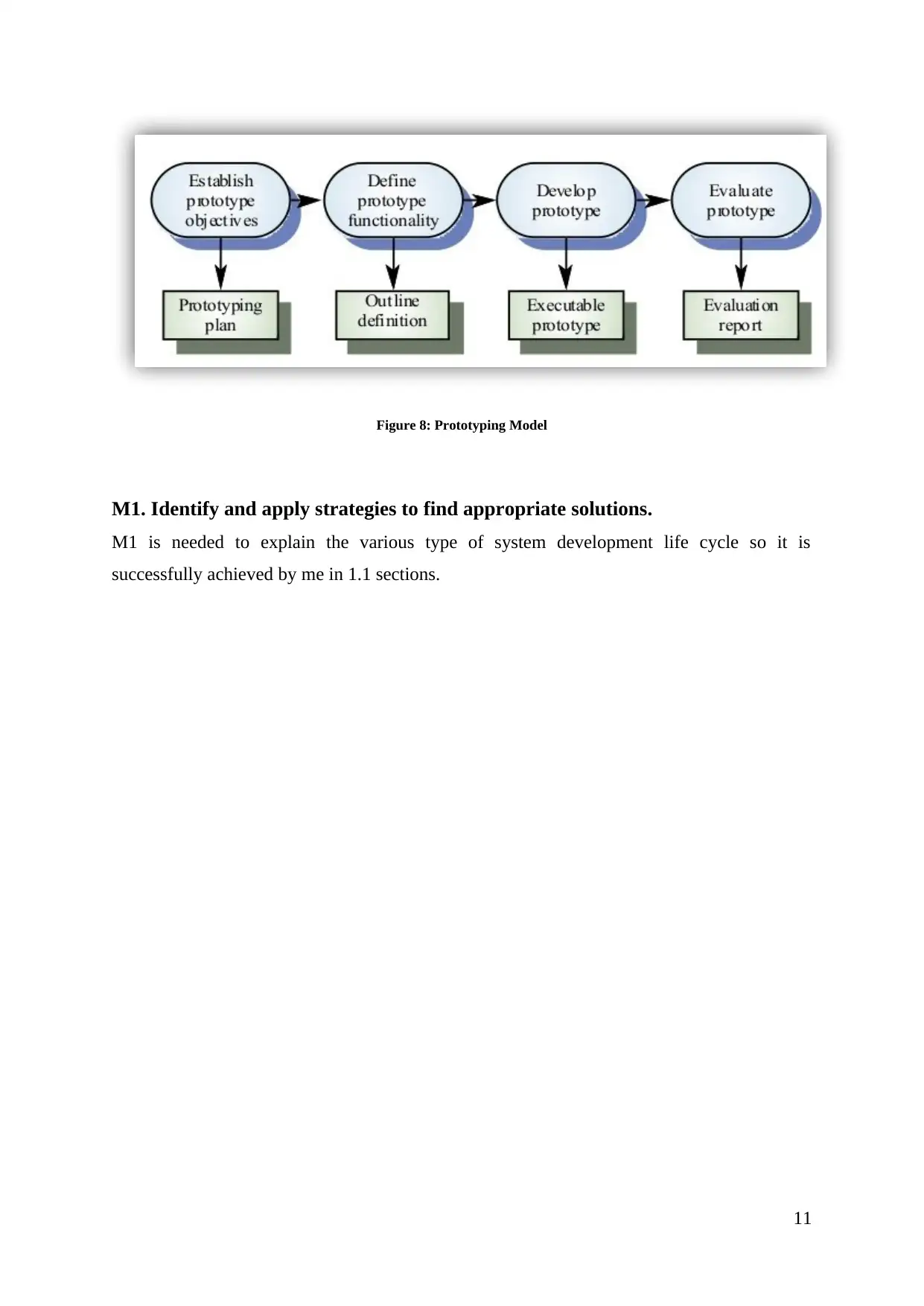
Figure 8: Prototyping Model
M1. Identify and apply strategies to find appropriate solutions.
M1 is needed to explain the various type of system development life cycle so it is
successfully achieved by me in 1.1 sections.
11
M1. Identify and apply strategies to find appropriate solutions.
M1 is needed to explain the various type of system development life cycle so it is
successfully achieved by me in 1.1 sections.
11
⊘ This is a preview!⊘
Do you want full access?
Subscribe today to unlock all pages.

Trusted by 1+ million students worldwide
1 out of 29
Related Documents
Your All-in-One AI-Powered Toolkit for Academic Success.
+13062052269
info@desklib.com
Available 24*7 on WhatsApp / Email
![[object Object]](/_next/static/media/star-bottom.7253800d.svg)
Unlock your academic potential
Copyright © 2020–2025 A2Z Services. All Rights Reserved. Developed and managed by ZUCOL.





